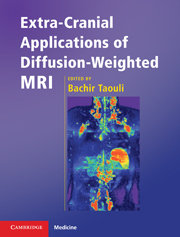Book contents
- Frontmatter
- Contents
- List of contributors
- Preface
- 1 Basic physical principles of body diffusion-weighted MRI
- 2 Diffusion-weighted MRI of the liver
- 3 Diffusion-weighted MRI of diffuse renal disease and kidney transplant
- 4 Diffusion-weighted MRI of focal renal masses
- 5 Diffusion-weighted MRI of the pancreas
- 6 Diffusion-weighted MRI of the prostate
- 7 Breast applications of diffusion-weighted MRI
- 8 Diffusion-weighted MRI of lymph nodes
- 9 Diffusion-weighted MRI of female pelvic tumors
- 10 Diffusion-weighted MRI of the bone marrow and the spine
- 11 Diffusion-weighted MRI of soft tissue tumors
- 12 Evaluation of tumor treatment response with diffusion-weighted MRI
- 13 Diffusion-weighted MRI: future directions
- Index
- References
5 - Diffusion-weighted MRI of the pancreas
Published online by Cambridge University Press: 10 November 2010
- Frontmatter
- Contents
- List of contributors
- Preface
- 1 Basic physical principles of body diffusion-weighted MRI
- 2 Diffusion-weighted MRI of the liver
- 3 Diffusion-weighted MRI of diffuse renal disease and kidney transplant
- 4 Diffusion-weighted MRI of focal renal masses
- 5 Diffusion-weighted MRI of the pancreas
- 6 Diffusion-weighted MRI of the prostate
- 7 Breast applications of diffusion-weighted MRI
- 8 Diffusion-weighted MRI of lymph nodes
- 9 Diffusion-weighted MRI of female pelvic tumors
- 10 Diffusion-weighted MRI of the bone marrow and the spine
- 11 Diffusion-weighted MRI of soft tissue tumors
- 12 Evaluation of tumor treatment response with diffusion-weighted MRI
- 13 Diffusion-weighted MRI: future directions
- Index
- References
Summary
Introduction
Pancreatic cancer is one of the leading causes of cancer-related death in the world with a poor 5-year survival rate. Despite recent advances in cross-sectional imaging, such as multidetector-row computed tomography (MDCT) or magnetic resonance (MR) imaging techniques, advanced disease at time of initial presentation results in a low rate of surgical interventions (10–20%) which is the cause of high mortality. CA19–9 is a sensitive tumor marker for diagnosis of pancreatic carcinoma but lacks specificity. Endoscopic ultrasound (EUS) is regarded as the modality of choice in patients with a high index of clinical suspicion and negative MDCT, but is invasive and operator dependent. Currently, contrast-enhanced MDCT is the primary imaging modality for the detection and staging of pancreatic adenocarcinoma. A meta-analysis of 86 studies revealed sensitivity and specificity of 84% and 82% for MRI versus 91% and 85% for helical CT for detection of pancreatic adenocarcinoma. MRI and fluoro-d-glucose positron emission tomography (FDG-PET) are complementary modalities to CT. Although contrast-enhanced CT achieves generally high sensitivity and specificity for the detection of pancreatic carcinoma, for staging and determination of resectability of the tumor, it is less specific in differentiating benign and malignant lesions. The differentiation of pancreatic adenocarcinoma from mass-forming pancreatitis is difficult because both share morphological characteristics at imaging. In the light of the limitations in diagnostic performance of the current imaging techniques, there is a compelling need for establishing an imaging technique as a cancer-screening method to provide high sensitivity for the detection and characterization of pancreatic tumors, and for the differentiation of tumors from benign inflammatory processes.
- Type
- Chapter
- Information
- Extra-Cranial Applications of Diffusion-Weighted MRI , pp. 55 - 71Publisher: Cambridge University PressPrint publication year: 2010



